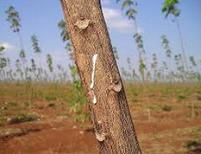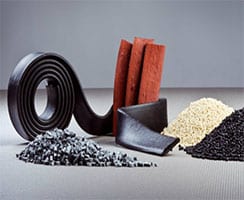 The term rubber , which comes from the Quechua word kawchu , refers to a product derived from latex : a fluid found in various plants. Rubber is made by different species of trees and allows us to obtain, after coagulation, an elastic and waterproof mass that has multiple uses.
The term rubber , which comes from the Quechua word kawchu , refers to a product derived from latex : a fluid found in various plants. Rubber is made by different species of trees and allows us to obtain, after coagulation, an elastic and waterproof mass that has multiple uses.
It is important to note that rubber can also be generated synthetically, through an industrial procedure. Therefore we can differentiate between natural rubber and synthetic rubber .
The use of rubber dates back to very ancient times. Pre-Columbian peoples in America already used rubber, for example making balls and footwear. Rubber production, in fact, favored the development of cities in the Amazon region such as Manaus and Iquitos. It should be noted that this growth was also based on the exploitation of the workers who were dedicated to obtaining rubber from the trees .
Among synthetic rubbers, on the other hand, acrylic rubber stands out, which is produced with acrylonitrile and has great resistance to high temperatures and oxidation.
The first people to take advantage of the properties of natural rubber were the Central American Indians, also known as the indigenous people of America, Native Americans or Amerindians , among other nicknames. These are the original inhabitants of the continent, whose current descendants try to maintain their culture despite the discrimination and dispossession they suffer from governments.
Regarding the use of rubber industrially, it was not until 1803 that the first factory dedicated specifically to the production of products with this material was inaugurated in Paris.
It should be noted that, in colloquial language and according to the country, the idea of rubber is used as a synonym for the tire of a vehicle or a piece of clothing used as protection from the rain.
rubber fever
 The historical stage that marked the development of various areas of Latin America based on the obtaining and sale of rubber is known as rubber fever . This process , developed between 1879 and 1912 , as well as between 1942 and 1945 , generated great economic and social changes in the regions involved.
The historical stage that marked the development of various areas of Latin America based on the obtaining and sale of rubber is known as rubber fever . This process , developed between 1879 and 1912 , as well as between 1942 and 1945 , generated great economic and social changes in the regions involved.
The rubber rush was a fundamental part of the social and economic history of several countries with territories in the Amazon region, including Peru, Colombia, Brazil, Ecuador, Bolivia and, although not to the same degree, Venezuela. The term "fever" in this case is used to describe the great use that rubber was given at that time.
The fever that led these countries to extract and market rubber in such high volumes boosted wealth and caused social and cultural transformations. Some cities, such as Belém and Manaus in Brazil and Iquitos in Peru, were especially benefited by the impact of this exploitation .
The rise of the rubber rush took place in two periods, as mentioned in a previous paragraph. In the 1850s the discovery of the pneumatic chamber and vulcanization took place, which led to an increase in the volume of rubber extraction .
Vulcanization, for its part, is a process that consists of heating raw rubber together with sulfur so that it becomes more rigid and resistant to low temperatures . The American inventor Charles Goodyear discovered it in 1839 when he accidentally overturned a container containing rubber and sulfur on a stove; The mixture became stiff and impermeable, and Goodyear decided to name the process after Vulcan, the Roman god of volcanoes and fire.
